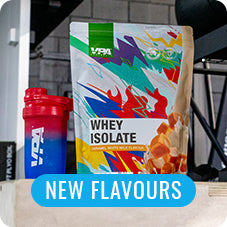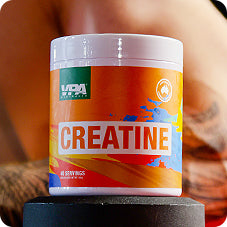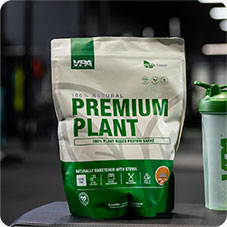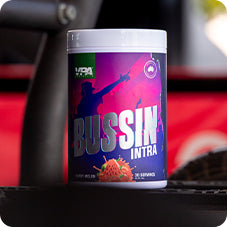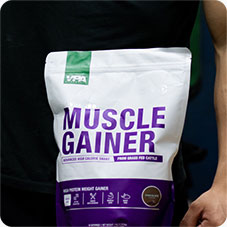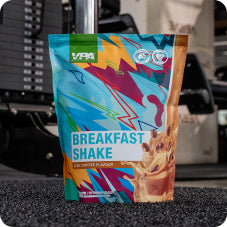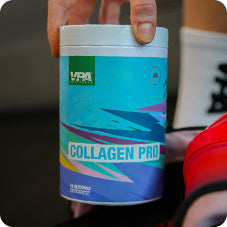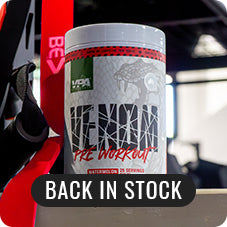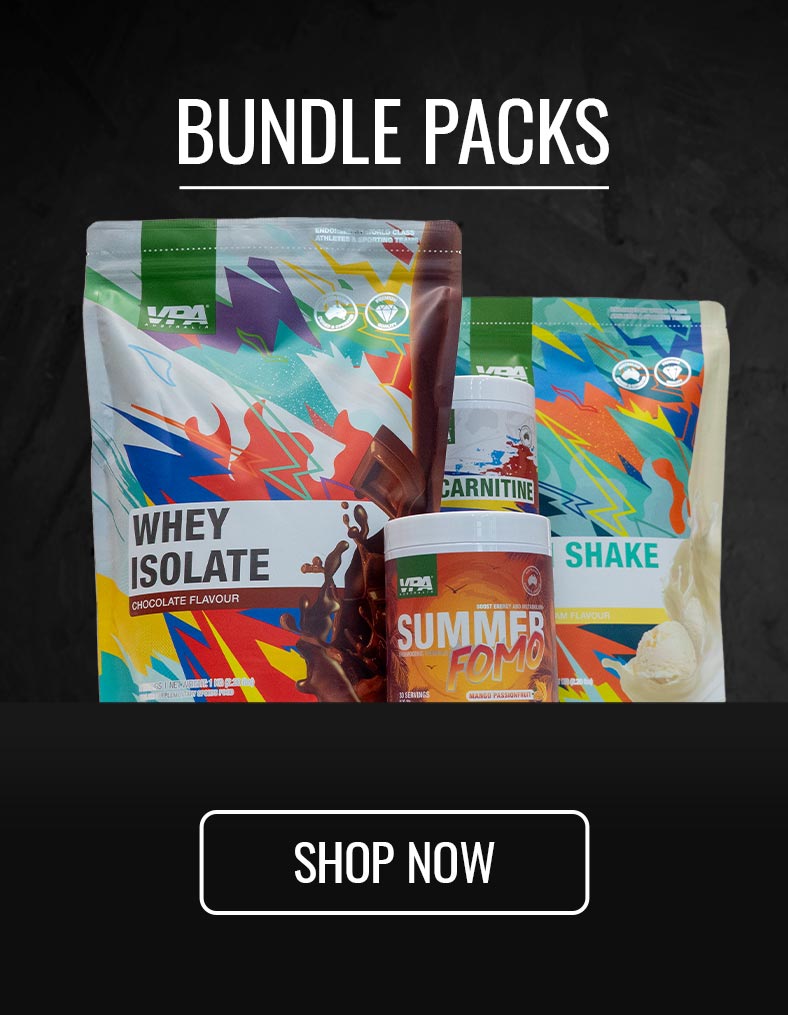- $0.00 AUD Subtotal
How Is Protein Powder Made? A Comprehensive Guide
February 19, 2025 7 min read

For gym enthusiasts and athletes worldwide, protein powder is a staple, and its consumption is almost religiously followed. However, fitness geeks often want to learn about everything that goes into their bodies. Therefore, a common question usually arises: How is protein powder made?
This guide comprehensively examines the entire process, exploring different types of protein powders, their manufacturing processes, and future trends in protein powder production. But before we dive into what protein powder is made of and the process, let’s first understand what protein powder is.
What Is Protein Powder?
Protein powder is a dietary supplement made from protein extracted from various sources, such as milk, plants, and eggs. The protein is processed into a finer powder and is commonly used to promote muscle growth and recovery and boost overall protein intake.
Protein is an essential macronutrient that supports various bodily functions, including muscle repair, enzyme production, and immune support.
But is protein powder good for you? While natural foods such as meat, fish, dairy, and legumes provide ample protein, many people use protein powders for convenience and efficiency and to supplement any protein deficiency if they fall short of their daily requirements.
Extensive processing of protein sources ensures a high-quality product with minimal fats and carbohydrates. This process improves digestibility and absorption, making protein powders an excellent supplement for individuals with specific dietary and fitness goals.
Types of Protein Powders
Based on their source, several protein powders are available, serving different dietary needs and preferences. Understanding the demarcation between plant-based protein vs. whey protein and other sources and what protein powder is made of can help consumers make informed choices about what they want to consume. This allows them to decide the best protein powder for them.
Whey Protein
Whey protein is one of the most popular protein powder supplements. It is derived from milk during cheese production. It has a complete amino profile, including all nine essential amino acids, making it an excellent protein source.
There are different types of whey protein, including:
-
-
Whey Protein Concentrate (WPC): Contains around 70-80% protein, with fats and carbohydrates.
-
Whey Protein Isolate (WPI):Contains 90% or more protein, removing most fats and carbs.
- Whey Protein Hydrolysate (WPH): Predigested through hydrolysis for faster absorption
-
Casein Protein
Another milk-based protein, casein, is digested more slowly than whey. While weighing between casein vs. whey protein, it is important to note that the slow digestion makes it ideal for nighttime recovery and prolonged muscle protein synthesis.
Plant-Based Protein
Plant-based protein powders have gained immense popularity among vegans, vegetarians, and those with dairy allergies. These include:
-
Pea Protein:Pea protein is derived from yellow split peas and is wholesome in branched-chain amino acids (BCAAs).
-
Soy Protein: Soy protein is a complete plant-based protein with all essential amino acids.
-
Hemp Protein: Hemp protein is high in omega-3 and omega-6 fatty acids, with a slightly nutty flavour.
-
Brown Rice Protein: When combined with pea protein, brown rice protein offers a complete amino acid profile.
Other Protein Types
Additional protein sources include:
-
Egg White Protein: Dried egg whites make up egg white protein powders that offer a high biological value to consumers.
-
Collagen Protein is popular for supporting joint and skin health but lacks essential amino acids for muscle growth.
-
Beef Protein: Derived from beef, this is used as an alternative to dairy-based proteins.
Production Processes for Different Protein Powders
Let’s finally dive into how protein powder is made.
Whey Protein Production
Making whey protein is no easy task. Liquid whey is just about 1% protein and requires aggressive refining. Separated from milk during cheese-making, liquid whey undergoes processing to remove fats and carbohydrates, leaving behind a high-protein concentrate. It is then pasteurised to kill natural bacteria and dried into powder form. Additional processing creates whey isolate and hydrolysed whey for increased concentration and digestibility. So, before you throw away the clear-ish liquid on top of your next cup of yoghurt, think twice! You could mix it in to maximise your protein intake.
Casein Protein Production
While it may seem as easy as setting curd at home, deriving casein protein is not as simple. After adding enzymes or acids to milk, it’s left to coagulate into curds. These curds are then separated from the liquid, dried, and ground into a fine powder. This process produces a slow-digesting protein source that releases amino acids over an extended period and keeps you fuller for a long time.
Plant-Based Protein Production
Plant-based proteins are produced by milling raw plant materials and extracting protein through filtration, centrifugation, and drying processes that remove unwanted fibre and starch. The resulting protein-rich substance is then processed into powder.
Turning Protein into Powder
Filtration and Purification
Filtration techniques such as ultrafiltration and microfiltration remove impurities while retaining protein content. Enzyme treatments may also break down proteins into smaller peptides for improved digestion.
Drying Techniques
Spray drying and freeze drying convert liquid protein concentrates into fine powder. Spray drying involves atomising the protein solution, while freeze drying removes extra moisture through sublimation, preserving nutrient integrity.
Flavouring and Enhancement
Gym enthusiasts always want new flavours and better textures in their protein powders, as they consume them regularly, sometimes even as meal supplements. Protein powders are often flavoured with cocoa, vanilla, or fruit extracts and are also available in premium flavours like honeycomb, salted caramel, and rainbow ice cream. Sweeteners such as stevia, sucralose, or monk fruit may be added. Some formulations include probiotics, digestive enzymes, or added vitamins to give them a holistic nutritional profile.
Packaging and Distribution
Protein powders require careful packaging in airtight containers to avoid contamination and extend shelf life. Packaging options include sealed tubs, airtight pouches, and single-serving sachets. Strict quality control ensures products meet safety and labelling standards before distribution.
Environmental Impact and Sustainability
Sustainable protein powder manufacturing includes eco-friendly ingredient sourcing, reducing water and energy consumption, and using recyclable packaging. Due to a lower carbon footprint plant-based proteins have a lower carbon footprint than animal-derived options. Many companies are investing in carbon-neutral production and ethical sourcing practices.
Regulatory Compliance and Safety Standards
Protein powder manufacturers must comply with stringent regulations, including:
-
Good Manufacturing Practices (GMP): Ensure clean and consistent production.
-
Third-Party Testing: Verify purity and absence of contaminants such as heavy metals and harmful additives.
-
Labelling Compliance: Providing a transparent ingredient that lists out complete nutritional information.
The Future of Protein Powder Production
Technological Advancements
Innovations in protein extraction, such as precision fermentation, which allows for the targeted production of specific proteins from alternatives like algae and fungi, high-pressure processing (HPP), and pulse electric field (PEF), are reshaping how protein powder is made. 3D food printing and AI-driven formulation enhance product development by optimising protein-rich sources.
Trends in Consumer Preferences
“Is protein powder good for you?” The answer is simple. Consumers increasingly demand clean-label products, attractive yet functional packaging, sustainable protein sources, and healthy additions such as adaptogens and probiotics in their protein supplements. Anything that meets the above criteria is good for consumers.
The VPA Protein Powder Difference
We are renowned for our high-quality protein powders, using premium ingredients and advanced protein powder manufacturing processes.
-
We take quality seriously, so Australia's top athletes use and trust our products. Almost 24,000 independent positive reviews show you who Australians prefer and trust.
-
Unlike other supplement providers, we take extreme measures to ensure our supplements are of the highest quality in the market. We employ third-party lab testing by the National Measurement Institute, the authority for Australia’s chemical, biological, physical and trade testing.
-
We are one of the few supplement companies certified by Informed Sport, the world leader in supplement quality assurance, and tested by LGC’s world-class sports anti-doping lab.
-
We are confident that you will love our supplements, and we have a product guarantee that ensures customers are happy with our products.
-
Because we have ISO and HACCP-certified warehouses in Brisbane, Sydney, and Melbourne, we can get your Whey Isolate to you faster than most supplement companies, with the highest level of hygiene possible in Australia. No more cheap and nasty unregulated supplement providers sending customers products that are packaged in unhygienic back rooms, with low accountability of quality, full of fillers and poor quality dairy products. Buy our protein powder supplements now.
FAQ
What is the process of making protein powder?
Protein powder is made by extracting protein from milk, plants, and eggs and then subjecting it to filtering, drying, flavouring, and packaging the final product.
Is protein powder made from animals?
Some protein powders, such as whey, casein, and egg protein, are derived from animal sources. However, plant-based alternatives from hemp, pea, soya, and rice are available and are preferred by vegans and sustainability advocates.
Are there plant-based alternatives to traditional protein powders?
Yes, plant-based protein powders, such as pea, soy, and hemp protein, offer excellent alternatives for those avoiding animal products.
How do manufacturers ensure the quality of protein powder?
Quality assurance involves sourcing premium raw materials, following strict manufacturing standards, and conducting rigorous testing for purity and safety.
Can protein powder be made sustainably?
Sustainable practices include using eco-friendly ingredients, ethical sourcing, and reducing waste through efficient production.
What should consumers look for when choosing a protein powder?
Consumers ensure high-quality ingredients, transparent labelling, third-party testing, and suitability for their dietary needs.
Understanding how protein powder is made can help consumers make informed choices about their supplements. Whether opting for whey, casein, or plant-based options, knowing the ingredients and manufacturing process ensures transparency and confidence in the products they use.
References:
-
Alasi, S. O., Sanusi, M. S., Sunmonu, M. O., Odewole, M. M., & Adepoju, A. L. (2024, February 7). Exploring recent developments in novel technologies and AI integration for plant-based protein functionality: A review. Retrieved from https://www.sciencedirect.com/science/article/pii/S2666154324000735#:~:text=Modifying%20protein%20structure%20through%20these,preferences%20and%20eco%2Dfriendly%20standards.
-
VPA Australia. (n.d.). Discover the best Australian protein powders. Retrieved from
https://www.vpa.com.au/collections/protein-powder
-
Crowley, B. (n.d.). How whey protein is made? Retrieved from
-
https://www.bulknutrients.com.au/blog/product-information/how-whey-protein-is-made
Also in Supplements

Stamina vs Endurance: Understanding the Key Differences and How to Improve Both
March 13, 2025 7 min read
Read More Recent Articles
- Collagen Protein vs Whey Protein: Which One Should You Choose?
- Stamina vs Endurance: Understanding the Key Differences and How to Improve Both
- BCAA vs Creatine: Which Supplement is Right for You?
- Best Supplements for Muscle Gain: What Really Works?
- What to Look for in a Pre-Workout: Key Ingredients Explained
- How Is Protein Powder Made? A Comprehensive Guide
- Creatine Before or After Workout: When Is Best?
- How Long Does Pre-Workout Last? Find Out to Maximise Your Sessions
- Whey Protein for Weight Loss: How It Helps and Best Practices
- Best Protein Powders in Australia and How to Choose the Right One for You

